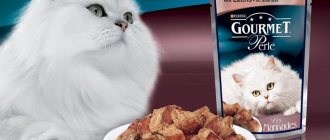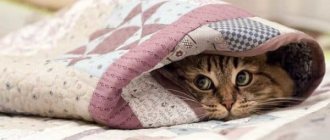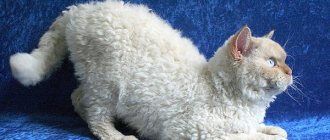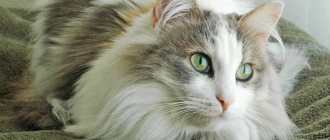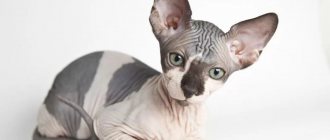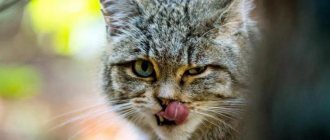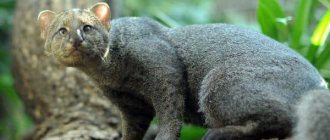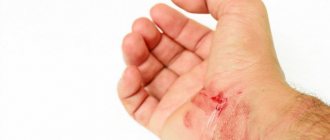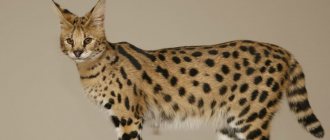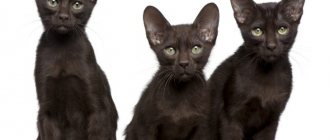Cat psychology
The main feature of the psychology of cats is their independence.
These pets cannot be forced to obey and follow commands. Walking on their own, they will only do what they want. Willfulness is not a disadvantage of mustachioed tabbies; on the contrary, cat lovers appreciate them for this. The gracefulness, grace and soft gait of the “little tiger” have inspired artists, musicians and writers for centuries. It’s not for nothing that a beautiful, spectacular woman is sometimes compared to a cat. Despite her love of freedom, a cat is capable of sincerely becoming attached to a person, and the more valuable her love will be. Cats are able to react sensitively to changes in the owner’s mood and even feel his pain. Having decided to have a cute kitten in the house, we subconsciously strive to come into contact with wild nature, because a small predator can be picked up and caressed.
A cat in the house is associated with comfort, prosperity and happiness. A purring baby curled up in a ball makes you take your mind off minor problems and gives you a feeling of warmth. There are also very playful, active cats, but their whims do not cause inconvenience and are perceived as funny little pranks. In order for living together with a cat to be joyful and comfortable, your characters must be compatible - just like people!
Characters of cats of different breeds
The characters of cats of different breeds can be divided into 3 groups:
- sociable and sociable;
- calm and balanced;
- powerful and proud.
It is very difficult to answer the question of which cat’s character is better; it all depends on what is closer to you. Each group has its own characteristics that must be taken into account when choosing a kitten. By the way, precisely in order to know what to expect from a cat in terms of character and behavior, it is better to give preference to purebred animals. Each breed is characterized by certain well-established specific behavioral characteristics. The likelihood that a cat's behavior will correspond to expectations will be higher in pets with a pedigree.
Sociable and sociable
Cats whose characteristic feature is excessive sociability simply adore their owners! Kotofey can spend hours with his family, keep an eye on everyone and keep up the conversation with a cheerful meow - a real “life of the party.” When there is someone at home, the cat does not leave a single step from him, rubs against his legs, lies in his arms, and jumps on his shoulder. In some ways, cats of this type can even be called annoying; some consider them clingy. But here it is important that such cats are taken into the home specifically for communication, since these animals vitally need the presence of a person nearby. They have difficulty experiencing loneliness, so they are not suitable for extremely busy people who return home only to sleep. In addition, sociable cats cannot tolerate rough treatment; they only understand the language of affection.
The other side of the coin is the jealousy of cats. They become so attached to their owner that they do not want to share him with anyone - neither with other pets nor with family members.
The group of “social and sociable” cats includes the Siamese cat, German Rex, Canadian Sphynx, Oriental and Bengal cats.
Siamese cat
German Rex
Canadian Sphynx
Oriental cat
Bengal cat
Calm and balanced
The calmness and balance of these cats are the result of a very stable nervous system. Animals that belong to this subgroup by nature never show aggression. Calm cats are perfect for families with small children. Affectionate and flexible, they will never be too intrusive. Such cats do not pester people on their own, but they will gladly allow themselves to be picked up, stroked or scratched behind the ears.
However, even with such balanced cats, caution must be exercised. If you hurt them, even by accident, the result may be a sudden change in behavior - the cat will struggle, try to run away, and may inadvertently scratch or bite. To paraphrase the English poet John Dryden, let's say: “Fear the wrath of the patient cat.”
In this group, the following breeds have the most flexible character: Siberian cat, Russian Blue, American Curl, Norwegian Forest, Burmilla and Burmese cat.
Siberian cat
Russian blue cat
American Curl
Norwegian Forest Cat
Burmilla
Burmese cat
Powerful and proud
Most often, pride, independence and authority are characteristic of breeds that were developed on the basis of wild cats through direct selection. Accordingly, they retained natural habits from their wild ancestors, not least of which are the desire to dominate and self-sufficiency.
Coexisting side by side with such a cat, even for many years, one cannot say that it becomes completely domestic. Such cats do not tend to form strong attachments to humans. They would be offended by the definition of “our smaller brothers” - these are full-fledged and full-fledged members of the family, whose opinions will have to be taken into account. Cats will be docile and affectionate, but only until the moment when they themselves want to exchange mercy for anger. It is better not to have pets from this group for families with children, because it is difficult to predict the behavior of such a cat. It may simply be dangerous for a child to be near her.
On the other hand, a strong and independent cat is an excellent partner for busy people. She feels great alone and minds her own business. For the same reason, such a cat should be the only pet in the house - it has difficulty getting along with other animals.
The most popular representatives of this group are Maine Coon, British and Persian cats, Kuril and Japanese bobtails.
British Shorthair
Persian cat
Kurilian Bobtail
Japanese Bobtail
Maine Coon
Shorthair
Abyssinian cat
Abyssinian cats are true aristocrats. They are intelligent, self-respecting, independent, but at the same time very affectionate. These are inquisitive and active animals that need space to play and do not tolerate closed doors. They are smart and easily learn the rules of behavior in the house.
Breed characteristics
- Characteristic color: the back is dark, the chest, belly and paw surfaces are lighter;
- big ears;
- “let down” expressive eyes;
- "royal" posture.
Bengal cat
Bengal is considered one of the rarest and most expensive breeds. Bengal cats combine the features of a predator and a domestic pet: they are active, love to hunt, play with water, but do not pose any danger.
Breed characteristics
- Beautiful leopard print fur pattern;
- Blue eyes;
- large ears;
- large paws;
- long claws.
British cat
British cats are quite large cats, which can be recognized by the characteristic oval of their muzzle. They are true gentlemen: calm, calm, independent and completely non-aggressive. They rarely ask to be held, are not too active and never require increased attention.
Breed characteristics
- Dense, dense undercoat; round, strong body;
- wide chest;
- powerful paws;
- thick tail;
- large round eyes;
- pronounced cheeks;
- short nose;
- strong chin.
Egyptian Mau
This breed (Egyptian Mai) is considered one of the oldest. May are active and sociable animals that do not tolerate loneliness and require constant attention. They are curious and very talkative. May, like many other descendants of wild cats, love water and are relaxed about bathing.
Breed characteristics
Characteristic spotted color: each hair should have 2-3 ticking rings; the coat is short, dense, thick, silky; dark rings on the tail; two dark lines under the eyes.
Oriental cat
These cats are quite harmoniously built. However, the ears of Orientals (Oriental Shorthair) look simply gigantic in comparison with their sophisticated build. Oriental cats are very friendly, sociable, curious, smart and intelligent. They love to participate in everything that happens in the house, they tolerate traveling calmly, but do not tolerate loneliness.
Breed characteristics
- Very short shiny coat;
- graceful elongated body;
- long legs;
- The huge ears are wide at the base and set low.
Devon Rex
Devon Rex are affectionate and energetic. Like other rexes, they are a kind of “cotops” in character. They are loving, active and devoted to their owner.
Breed characteristics
- Short coat with a wide curl;
- large, low-set ears, shaped like a butterfly;
- huge expressive eyes;
- slightly upturned nose;
- short muzzle.
Russian blue cat
Russian Blue cats are noble, loyal, calm, not too trusting of strangers, but friendly and affectionate with their owners. They are unobtrusive, do not require attention, and are very gentle if they want communication.
Breed characteristics
- Plush wool;
- elongated graceful body;
- high-set ears with sharp tips;
- big eyes;
- the nose and paw pads are blue-gray.
Savannah
Savannah is a hybrid of the African wild serval with a domestic cat. These are active, inquisitive creatures with a balanced character. They easily adapt to any conditions, but, being quite large animals, they need a lot of space to play. They love communication and do not tolerate loneliness, love walks in the fresh air, and show interest in water.
Breed characteristics
Thick spotted coat; large oblong body; elongated neck; long paws; large round ears.
Siamese cat
Siamese (Siamese) are unusually active and sociable. They do not like loneliness and require maximum attention, become very attached to their owner and follow him everywhere. These cats are smart and easily understand what is required of them, but can be stubborn. They have a gentle melodic voice and love to “talk”, thereby expressing emotions.
Breed characteristics
- Very short, silky, pointing coat;
- elongated wedge-shaped head;
- almond-shaped blue eyes;
- large, distinctively set ears.
Singapura cat
Singapuras are the smallest breed of domestic cats in the world. The weight of an adult male does not exceed 3 kg, females - 2 kg. Singapuras are absolutely non-aggressive, incredibly smart and affectionate with people. If you choose a Singapura cat as a pet, you will have to be very careful not to step on this curious little creature.
Breed characteristics
- Silky wool;
- small body;
- round head;
- big ears;
- huge round eyes.
Thai cat
Thai cats (Thai) are very “talkative”; they often give voice and express their emotions using various intonations. Thais tend to divide people into friends and foes: they are always affectionate towards the owner, but they can be wary of strangers. They can even grumble, but usually do not show aggression.
Breed characteristics
- Strong body;
- rounded head shape;
- Blue eyes;
- pronounced cheeks.
Toyger
Toy tiger - this is how you can decipher the name of the breed, made up of two words: toy - toy and tiger - tiger. Despite its appearance, similar to a wild animal, the Toyger is a real pet. He is endowed with a balanced character, curious and sociable. Loves to spend time with people, playful but not annoying.
Breed characteristics
- Muscular body;
- soft wool;
- black, brown or bronze vertical stripes, distinct both on the back and on the light belly;
- head, shaped like a hexagon, wide at the cheekbones;
- nose, narrowed between the eyes and widening towards the tip;
- long flexible tail.
Scottish fold cat
Scottish Folds are sociable, they easily get along with other pets, as well as small children, and quickly adapt to any living conditions. Short, forward-curved ears are the result of a spontaneous genetic mutation.
Breed characteristics
- Thick soft wool;
- large round eyes;
- short, forward-curved ears.
Exotic
These animals with a doll-like face, a phlegmatic character and magnificent plush fur are similar in character to the Persians. Exotic cats are very trusting and affectionate. They love to run and play, especially in childhood, but they sleep more than other cats.
Breed characteristics
- Short plush coat;
- large round head; small ears directed forward;
- round expressive eyes;
- short snub nose;
- pronounced cheeks;
- short thick tail.
Cat's temperament
In addition to what breed a cat belongs to, from birth it has a certain temperament. So, when we come to the nursery to choose a kitten, we can notice that babies from the same litter behave differently: some play and frolic on their own, some easily make contact and seem to say “pick me,” and some something hides in the corner or behind the mother cat.
By analogy with human temperaments, cats are divided into
- choleric people,
- sanguine people,
- melancholic,
- phlegmatic people.
Choleric cat
Choleric cats are characterized by a desire for vigorous activity. They are active, prone to mood swings, and react violently to new things and sounds. So, if a guest comes into the house wearing rustling clothes, the cat will not calm down for a long time. A cat can express its surprise by loud meowing and even growling.
A choleric cat will never tolerate insult and will not restrain his emotions. He will immediately hit back with his paw or bite his opponent, no matter whether it is a person, a dog or another cat. Such a fluffy dog would be suitable for an owner who leads an active lifestyle and has an explosive temperament. If there are small children in the family, you will have to be very careful with such a cat; you don’t always know what to expect from her.
Sanguine cat
A sanguine cat is ideal for the home. She quickly gets used to the new environment, gets along with other pets and loves children very much. Once in the house, the kitten will quickly adapt and begin to explore the room and will not hide in the corners. Sanguine people are playful and active, but not excessively.
But how do you get a cat with such a great character? When examining kittens from a breeder, pay attention to babies who are calmer than others. A sanguine cat has a strong constitution, will easily make contact with you, and will not squeak or scream for too long.
Phlegmatic cat
Phlegmatic cats are calm and slow. The pet will not actively demonstrate its emotions and rush around the apartment; rather, it can be called closed, restrained, and balanced. A phlegmatic cat will feel comfortable even in a small apartment, where she can sleep almost all day. If you want to play with her, the cat will most likely just watch your attempts.
This type of cat is perfect for older people, workaholics who are away from home, and those who like to while away time on the couch. The weak point of phlegmatic people is the tendency to obesity, which is a consequence of low activity. It is important to monitor your cat's diet and buy new toys that will help excite her.
Melancholic cat
Vulnerable and sensitive melancholic cats are characterized by increased anxiety. They are easily offended, they are afraid of strangers, and it takes a long time to get used to new furniture in the house. Under no circumstances should you shout at a melancholic cat, much less punish her physically. Talk to your beauty every day in a calm voice and stroke her.
The big advantage of these cats, which outweighs all the disadvantages, is their endless devotion and love for humans. They can be called monogamous. The owner becomes their friend for life.
Phlegmatic cat
A little slow, calm, she can persistently seek a treat, but she will not meow loudly, unlike choleric cats. This cat is also unlikely to show you its mood. It is almost impossible to anger this cat; she is calm and self-possessed. Sometimes a phlegmatic cat can watch what is happening indifferently. These are the cats that can sleep all day long, and to involve her in play you need to try very hard. Cats of this temperament are suitable for older people or very busy people who cannot devote much time to their pet.
The character of a cat and a cat after castration and sterilization
Owners of spayed and sterilized cats note that after undergoing surgery, their pets became calmer and more balanced. Since male cats are not eager to find a partner, they do not run away from home and do not organize cat “concerts”. Animals are more flexible and affectionate, and their activity level may decrease.
However, you should not expect dramatic changes in the character of a sterilized cat or neutered cat. Pets who are not accustomed to scratching posts continue to tear up furniture, and angry furries continue to hiss and scratch. But good-natured cats will definitely maintain a positive attitude and will not sharpen their teeth on their owners.

